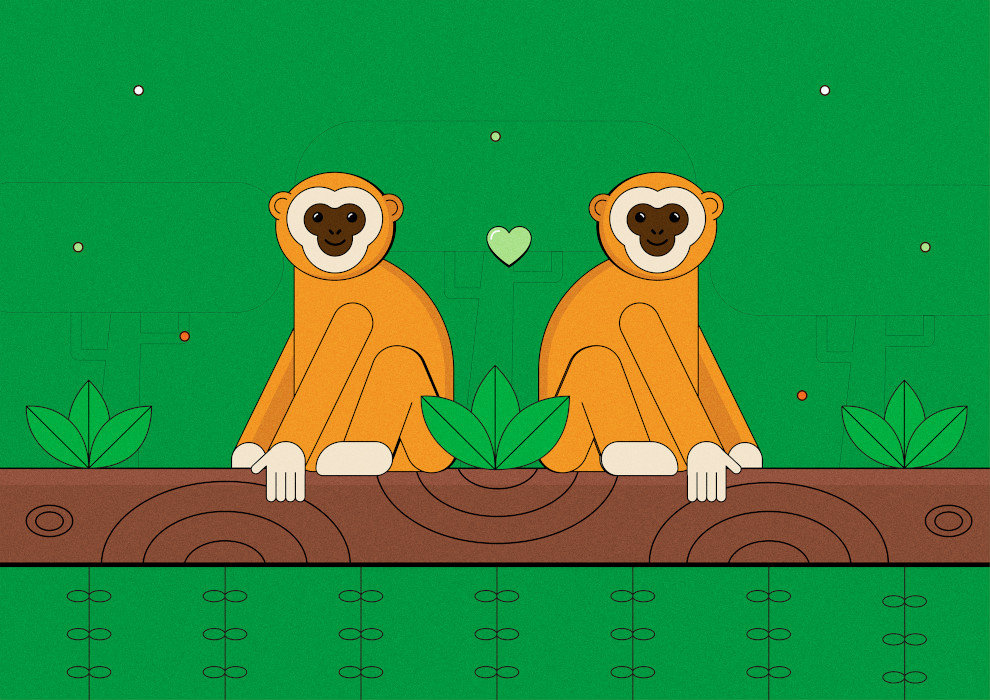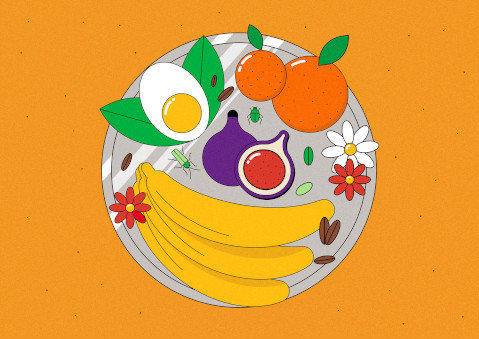Chanee’s
story
Chanee was born in Fayence, France. He has always loved animals, especially monkeys.
When he was young, he spent his free time observing gibbons in zoos. When he was 16, he wrote a book on gibbons’ behaviour which impressed many people because, in France, no one had ever written a book on gibbons!
That’s how he became known and Muriel Robin, a famous actress, contacted him. She wanted to help him make his dream come true; go to Asia to help his gibbon friends… a As he had no money, she financed his project and it was, thanks to her, that he went to Indonesia in 1998.
At first, it was very hard because he didn’t speak the language, didn’t know anyone, didn’t know Indonesia; everything was new and he had to fend for himself. Many gibbons were captured in the forests and imprisoned in small cages … These animals were very unhappy and often they would die quickly. So Chanee started explaining to the Indonesians that it was wrong to kill gibbons to capture their babies and that they should be left free in their forest.
One day, he met a young girl named Prada. They got to know each other and got married. They have 2 boys, Andrew and Enzo, who also love the forest and animals.
If the forests disappears then the animals can no longer survive. It’s as if we destroyed your house and no longer gave you food!
On social medias, Chanee explains to young Indonesians about protecting nature and saving animals. Today, Chanee has saved many gibbons and other animals as well as forests. It’s a great story but it’s also difficult, because you have to fight all the time to continue to protect them!

What are gibbons ?
It is a primate that is part of the great ape family such as gorillas, orangutans, bonobos and chimpanzees.
You can recognise a great ape by the absence of a tail and its’ distinctive teeth.
There are 17 species of gibbons.
Both males and females defend their territory permanently: it is said to be a territorial species. Several pairs of gibbons, that share the same territory, can kill each other if the territory is too small.
Gibbons do not live in groups; they live in pairs. They sleep seated on a branch, close together, unlike, for example, orangutans, who build a nest in trees to sleep in.
In captivity (in zoos), it is impossible to put several pairs of adult gibbons in the same aviary. You can put young animals together but, once they are adults, you have to separate them and form pairs. At Kalaweit, this is what we do.
Gibbons live about 35 years.
They are the champions of the trees but not in the water because they cannot swim!


What do they look like ?
They are the smallest of the great apes, measuring between 70 cm and 1 meter in height. Compared to their size, they have the longest arms of any primate. They are considered to be the best acrobats in the world! They can jump 8 meters high and jump 10 meters between 2 branches! They weigh from 5 to 12 kg depending on the species.
The siamang, which is the largest species of gibbon, has a throat pouchVocal sac, located at the neck which inflates when the animal sings. This allows them to sing even louder and they can be heard up to 2 km away! In addition, their 2nd and 3 toes are webbed.
They have a round head, black face and round eyes.
The coat colour of gibbons can vary from beige to brown, gray and black. In some species, the coat varies depending on the sex.
Kloss’s gibbon is completely black like the siamang whose coat, however, is shaggier.

How do they live ?
They live in trees. They are arborealWho lives in trees. They eat mostly fruit and love figs. They also feed on seeds, flowers, bark and leaves.
Sometimes they eat insects, lizards, birds or eggs but these only makes up 10% of their diet.
Gibbons sing every morning to defend their territory! They say “be careful, I live here with my family, this is my territory so don’t try to come to my home”.
You can hear these songs 1 km away! It is unfortunately because of this very loud song that poachers easily locate gibbons in order to capture the babies …
Gibbons live in pairs with 1 to 4 young under the age of 7. At around the age of 7, the young ones must leave their father and mother, find a male or a female and their own territory. A gibbon’s life is not easy!
In which countries are they found?
They are found in the rainforests of South East Asia: China, Laos, Vietnam, Cambodia, Thailand, Bangladesh, Myanmar, North East India, Malaysia and, of course, Indonesia.
They live in the canopyUpper part of the forest or tree tops and share their trees with family members as well as other species such as orangutans or macaques that live a little lower down.
Are gibbons threatened with extinction?
Yes ! The main danger for the gibbon is man, who destroys the forests where they live and captures them to turn them into pets. But the gibbon is not a pet, it is a wild animal. They cannot survive in a small cage, without a mate.
Animals are captured when they are babies but unfortunately many die quickly … Fortunately, Chanee and the Kalaweit team often rescue these illegally held animals. The law prohibits keeping wild animals, especially when the species is rare.
The forests are disappearing
In indonesia, 90% of the forests have disappeared
In Indonesia, companies cut trees to make furniture, paper, parquet … and others burn forests to plant oil palmsA palm tree, native to Africa, which produces fruit used for oil, food and cosmetic products. These palms are used to make palm oil, which is sold all over the world.
To live, animals need a forest where there are many different trees and plants. When there are only oil palms, animals can no longer survive.

Other animals
In some countries in Asia, people think that you can cure diseases by using pieces of animals: bones, teeth, nails, horns, etc. This is untrue but many people believe it.
Kalaweit has also rescued bears, crocodiles and many other species. In Indonesia there are small bears, which are trafficked just like the gibbons, orangutans, lorises and many other species. In Borneo, there are around 6,000 gibbons that are kept by Indonesians in their homes, usually in a very small cage. This is prohibited by law but it is not very respected …
Lorises
They are small, nocturnal primates with very large eyes that are found in Asia. There are 8 different species, including 3 in Indonesia.
They are 20 cm tall, have a round head with large eyes and a small muzzle.
Their fur can be gray, yellow, or brown. They live in trees and move very slowly which makes them easy to capture.
They are the only primate to manufacture poison, which makes their bite dangerous.
They are trafficked for sale as pets. The species is threatened with extinction.
Crocodiles with gibbons?
In the Gibbon Conservation CenterThis is the name given to the 2 reception centers for gibbons and other animals collected by Kalaweit. Gibbons are placed in aviaries and bears or crocodiles in enclosures of Pararawen in Borneo, we have a crocodile that had been raised for 17 years by a witch doctor who took good care of it.
In Indonesia, witch doctors are highly respected. The crocodile was in a small enclosure and had grown too big.
Since this rescue, the witch doctor, who has become Chanee’s friend, has told the villagers that wild animals must be protected and left in the forest. This crocodile is now in a large enclosure and has been joined by other crocodiles …
Bears
Kalaweit has already saved 12 bears. They are Malay bears. They are Berli, Big Bear (the first to be saved by Kalaweit), Lucie, Luna, Teki, Agri …
And at the Gibbon Conservation CenterThis is the name given to the 2 reception centers for gibbons and other animals collected by Kalaweit. Gibbons are placed in aviaries and bears or crocodiles in enclosures in Sumatra, there are other bears also saved by Kalaweit.
All of these bears have the same sad story as the gibbons. They were captured when they were babies to be sold as pets. But the bear is a wild animal and it cannot live in a very small cage. Kalaweit gives them a better life.
Macaques
It is the monkey group that has the most different species: 22 different species that live in Asia and Africa.
It is a monkey which lives in a group in which there is a hierarchyClassification of individuals according to their role within the group.
In general, they swim very well and love to steal food or items from tourists who get too close to them!
They live about 30 years.
Become a friend of kalaweit and sponsor a gibbon!
You can ask your parents to help you sponsor a gibbon. Just choose an animal from the list and you will regularly receive news of your gibbon by email and your name will be displayed on the list on our website.
Gibbons are disappearing because their forest is being destroyed to plant oil palm treesA palm tree, native to Africa, which produces fruit used for oil, food and cosmetic products. Palm oil is used in many products: Nutella, crisps, cookies, cereals, soaps, ice cream, toothpaste, in gasoline in cars … To save the gibbons refuse products that contain palm oil!
By avoiding wasting paper, tissues, toilet paper, you can also protect the forest.
